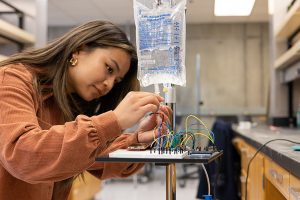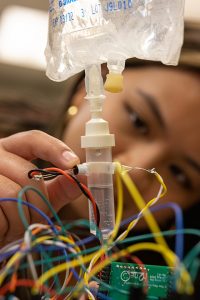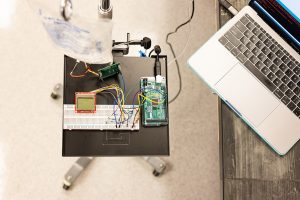By Wayne Gillam | UW ECE News

A team of UW ECE undergraduate students, led by UW ECE Professor Denise Wilson and Dr. Gregory Valentine from the pediatrics department at UW Medicine, has engineered a low-cost, accessible and highly accurate intravenous (IV) fluid monitor. This new device promises to improve newborn infant health outcomes around the globe, particularly in low- and middle-income countries. Above: UW ECE graduate student Jan Silva adjusts the team’s prototype. Photo by Ryan Hoover | UW ECE
According to the World Health Organization, the first month of life is the most vulnerable time for a child’s survival. Globally, almost half of all deaths under the age of five occur within the first four weeks, a span of time known as the newborn, or neonatal, period. For a variety of reasons, including better access to healthcare, the number of newborns who pass away every year has been halved since 1990, and that’s remarkable progress. However, the mortality rate for newborns is still staggeringly high worldwide. For example, in 2020, 2.4 million children died in their first month of life, with the vast majority of those deaths taking place in low- and middle-income countries around the world.
Dr. Gregory Valentine, an assistant professor of pediatrics and neonatologist in the UW School of Medicine, is probably more aware of this sobering fact than most. Valentine participates in several working groups at the World Health Organization focused on newborn healthcare, and he has witnessed the challenges for infants in under-resourced areas firsthand, having spent time working as a physician in a Malawi hospital’s neonatal intensive care unit. He also conducts ongoing research on how to improve newborn health outcomes in countries such as Kenya, Ethiopia, the Central African Republic and India.
“When I was in Malawi, I saw babies die — at one point, two to four babies a day. Most lost significant weight within two to three days after birth and became severely dehydrated without access to IV [intravenous] fluids,” Valentine said. “So, that’s why I have focused my efforts on the newborn population. At the hospital in Malawi, there were not enough working IV pumps for all the babies, and even in developed countries, there currently isn’t a low-cost IV monitor available that counts drops and can detect infusion rates as low as what is needed for a small and sick newborn.”

Dr. Gregory Valentine (left) and UW ECE Professor Denise Wilson (right). Wilson joined Valentine’s team in 2021 to help oversee prototype development and publish the research team’s findings.
To help address this urgent need, Valentine consulted with his medical colleagues in Malawi and began a partnership in 2019 with the UW Engineering Innovation in Health program. Since then, through the EIH program, Valentine has been leading teams of students from UW ECE and mechanical engineering toward developing a low-cost, accessible, and highly accurate IV fluid pump and monitor. In 2020, these efforts received a $50K CoMotion Innovation Gap Fund Award, which assisted with prototype refinement and development.
In 2021, Valentine connected with UW ECE Professor Denise Wilson through people he met in the EIH program. He brought Wilson into the team to help oversee prototype development and publish research findings. Wilson is an expert in sensor systems and engineering education research. She is also the UW ECE associate chair for diversity, equity, and inclusion.
“I have a strong interest and passion in applying engineering technology to resolve equity issues and to help support a better world,” Wilson said. “We have a lot of evidence that many students enter engineering to find opportunities to benefit society. They’re motivated by altruism. Giving students these opportunities not only supports these kinds of projects, but it also helps students persist in areas of engineering where society needs them the most.”

Malawi is where Dr. Valentine worked as a physician.
Now, Valentine and Wilson’s EIH team, which includes three UW ECE undergraduate students, has published the results of their research. As described in a recent paper in IEEE Sensors Letters, the group has successfully engineered a low-cost, accessible and highly accurate IV fluid monitor, one that promises to improve health outcomes around the globe, especially for newborns in under-resourced areas.
“This project uniquely exposed me to the prototyping stages of product development, where we were directly involved with important design decisions,” said Jan Silva, lead author and UW ECE graduate student. Silva was an undergraduate student when research described in the paper took place. “Working with Dr. Valentine, Professor Wilson and the team and learning about the motivation for this project also inspired me to continue pursuing projects in equitable and accessible healthcare.”
Low cost, accessible, highly accurate

The research team’s prototype, H2neO, has been demonstrated to be more accurate than existing commercial IV monitors that count drops using conventional gravity methods and over twice as accurate at monitoring low drip rates. H2neO uses optical sensing and sophisticated signal processing to go beyond drop counting. In addition to detecting drops in the fluid tube, the device also observes the shape of the drops themselves. This provides more robust data for the monitor, which improves accuracy. Photo by Ryan Hoover | UW ECE
IV fluids deliver hydration, nutrition and medications. These can be critical to sustaining life, especially for premature or sick newborns. But because of their small size, newborns receive far less fluid than an older child or an adult. This fact translates to a low, very slow IV fluid drip rate that can be difficult, and in some cases impossible, to monitor with precision.
The research team’s prototype (called H2neO, which stands for “Hydration to Neonates,”) has been demonstrated to be more accurate than existing commercial IV monitors that count drops using conventional gravity methods to deliver IV fluids to babies. In fact, H2neO has been found to be over twice as accurate at monitoring low drip rates. It also is capable of monitoring drip rates that are lower than what can currently be detected with existing technology.
“Most of the work that has been done on IV monitors has been done with adults in mind. But with newborns, any mistake in monitoring can have severe consequences,” Wilson said. “There are tiny distinctions regarding when an actual drop is occurring, and therefore, this can create small sensing errors, which become a bigger percentage of the overall accuracy of the system with lower fluid rates. Our device, which was developed with newborns in mind, addresses these issues.”
Most IV monitors today simply detect and count the drops that occur within the fluid tube. But H2neO uses optical sensing and sophisticated signal processing to go beyond drop counting. In addition to detecting drops in the fluid tube, the device also observes the shape of the drops themselves. This provides more robust data for the monitor, which improves accuracy.
The prototype is also designed so it can be adapted to run on rechargeable solar batteries, with minimal power consumption. This helps to lower costs and is a key feature for people in health care systems with unreliable or nonexistent access to an electrical power grid. And while the original intent behind this device was to help make newborn healthcare more affordable and accessible in under-resourced areas, Valentine noted that H2neO could also help to save lives in high-income countries — for example, in higher-resourced neonatal intensive care units, rural communities, military deployments, or after a natural disaster such as a hurricane or an earthquake.
The path to real-world implementation

An overhead shot of the research team’s device, H2neO. Next steps for prototype development include compacting and optimizing the device by fine-tuning electrical and system components. Photo by Ryan Hoover | UW ECE
Valentine is also working with undergraduate students in the mechanical engineering department, where he is an adjunct professor. There, he and the students are developing a regulator that will assist in ensuring precise flow rates are maintained in the next version of the prototype. This will allow H2neO to use gravity to move fluid, rather than IV pumps that rely on a continuous supply of electricity. The innovation will help further reduce power requirements for the device.
Next steps for prototype development include fine-tuning electrical and system components and many rounds of rigorous testing to ensure the device will be safe to use on people, especially newborns. For this purpose, Valentine is in close contact with several individuals, institutions, and experts in low- and middle-income countries, such as St. Paul’s Hospital Medical Millennium College in Addis Ababa, Ethiopia, which has voiced interest in collaborating in clinical trials. Device development will continue through the EIH program, which provides valuable educational opportunities such as this for UW engineering students.
“There are real, important opportunities for engineers in all fields to make a difference in low- and middle-income countries, especially in regard to healthcare access,” Wilson said. “These types of devices and systems have an enormous number of challenges and interesting things to do that engineering students can benefit from. I enjoy watching students solve problems that are driven by application and especially by these sorts of urgent issues.”
For more information about this research, please contact Dr. Gregory Valentine or UW ECE Professor Denise Wilson.

